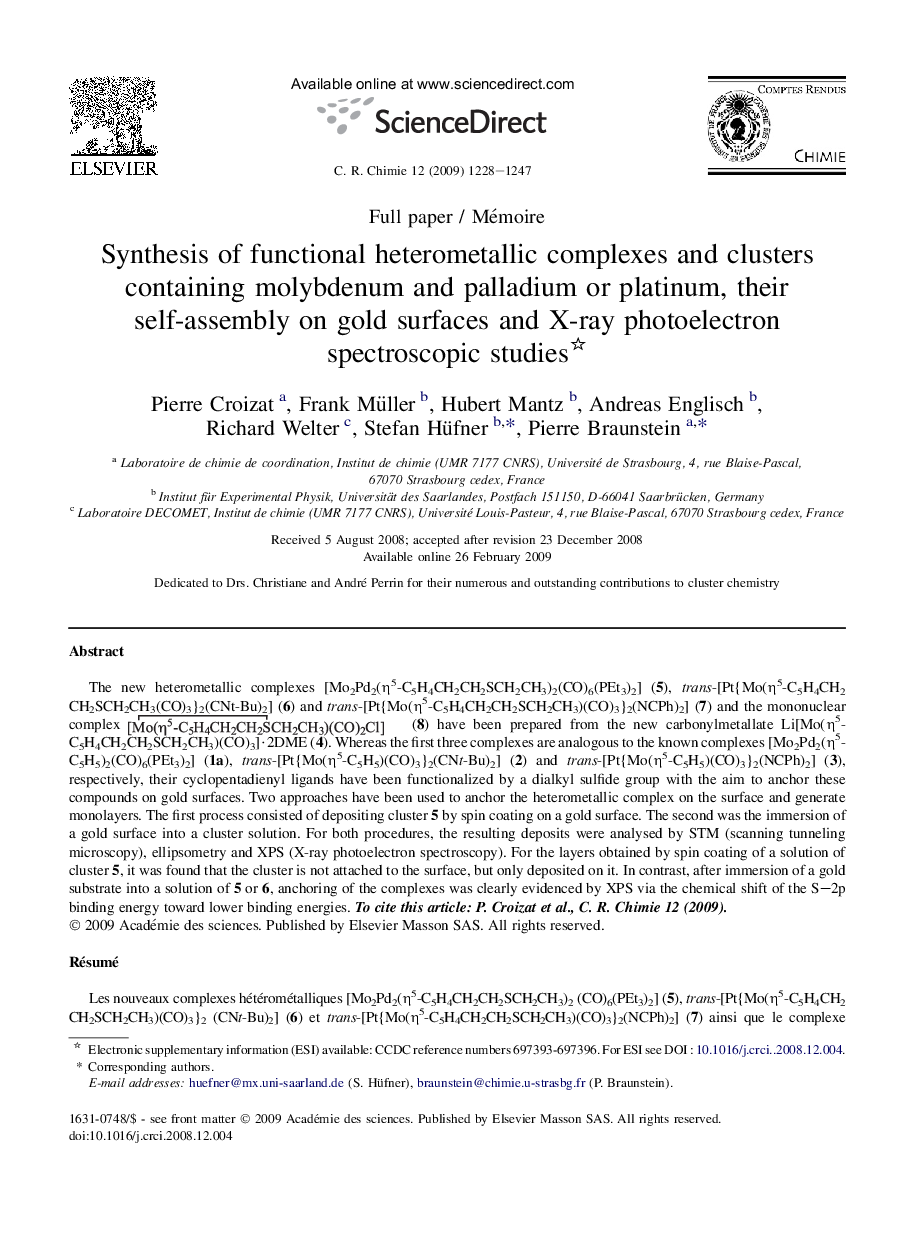| کد مقاله | کد نشریه | سال انتشار | مقاله انگلیسی | نسخه تمام متن |
|---|---|---|---|---|
| 171315 | 458448 | 2009 | 20 صفحه PDF | دانلود رایگان |

The new heterometallic complexes [Mo2Pd2(η5-C5H4CH2CH2SCH2CH3)2(CO)6(PEt3)2] (5), trans-[Pt{Mo(η5-C5H4CH2CH2SCH2CH3(CO)3}2(CNt-Bu)2] (6) and trans-[Pt{Mo(η5-C5H4CH2CH2SCH2CH3)(CO)3}2(NCPh)2] (7) and the mononuclear complex (8) have been prepared from the new carbonylmetallate Li[Mo(η5-C5H4CH2CH2SCH2CH3)(CO)3]·2DME (4). Whereas the first three complexes are analogous to the known complexes [Mo2Pd2(η5-C5H5)2(CO)6(PEt3)2] (1a), trans-[Pt{Mo(η5-C5H5)(CO)3}2(CNt-Bu)2] (2) and trans-[Pt{Mo(η5-C5H5)(CO)3}2(NCPh)2] (3), respectively, their cyclopentadienyl ligands have been functionalized by a dialkyl sulfide group with the aim to anchor these compounds on gold surfaces. Two approaches have been used to anchor the heterometallic complex on the surface and generate monolayers. The first process consisted of depositing cluster 5 by spin coating on a gold surface. The second was the immersion of a gold surface into a cluster solution. For both procedures, the resulting deposits were analysed by STM (scanning tunneling microscopy), ellipsometry and XPS (X-ray photoelectron spectroscopy). For the layers obtained by spin coating of a solution of cluster 5, it was found that the cluster is not attached to the surface, but only deposited on it. In contrast, after immersion of a gold substrate into a solution of 5 or 6, anchoring of the complexes was clearly evidenced by XPS via the chemical shift of the S–2p binding energy toward lower binding energies.
RésuméLes nouveaux complexes hétérométalliques [Mo2Pd2(η5-C5H4CH2CH2SCH2CH3)2 (CO)6(PEt3)2] (5), trans-[Pt{Mo(η5-C5H4CH2CH2SCH2CH3)(CO)3}2 (CNt-Bu)2] (6) et trans-[Pt{Mo(η5-C5H4CH2CH2SCH2CH3)(CO)3}2(NCPh)2] (7) ainsi que le complexe mononucléaire (8) ont été préparés à partir du nouveau carbonylmétallate Li[Mo(η5-C5H4CH2CH2SCH2CH3)(CO)3]·2DME (4). Si les trois premiers sont respectivement analogues aux complexes connus [Mo2Pd2(η5-C5H5)2(CO)6(PEt3)2] (1a), trans-[Pt{Mo(η5-C5H5)(CO)3}2(CNt-Bu)2] (2) et trans-[Pt{Mo(η5-C5H5)(CO)3}2(NCPh)2] (3), leur ligand cyclopentadiényle a par contre été fonctionnalisé par un groupement thioether afin de pouvoir les greffer sur des surfaces d'or. Pour ce faire, deux approches ont été mises en œuvre pour accrocher le complexe hétérométallique sur la surface et engendrer des monocouches. La première a consisté à déposer le cluster 5 par spin coating sur une surface d'or. La seconde a été l'immersion d'une surface d'or dans une solution de complexe. Ces couches ont ensuite été analysées par STM (Scanning tunneling microscopy), par ellipsométrie et par spectroscopie XPS (X-ray photoelectron spectroscopy). L'étude des couches obtenues par spin coating d'une solution du cluster 5 montre que le cluster n'est pas accroché mais simplement déposé sur la surface. En revanche, après immersion d'une feuille d'or dans une solution de 5 ou 6, on constate par XPS un réel accrochage des complexes sur la surface.
Journal: Comptes Rendus Chimie - Volume 12, Issues 10–11, October–November 2009, Pages 1228–1247